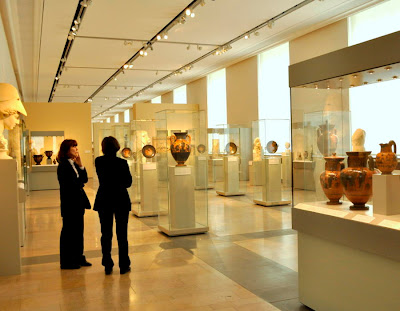Last Sunday John and I visited another incredible State collection on Berlin's Museum Island, this time the major collection of their Classical antiquities at the Altes Museum. Karl Friedrich Schinkel's Neo-Classical design for the museum hints at the treasures to be found inside.
The first room sets the stage with a collection of Attic sculptures
in marble. Torso of a Warrior, 530 BC.
and in bronze, Sacrifice-Bearer, 540-520 BC.
Cauldron Handle, 760-735 BC.
and pottery like this beautifully decorated vase. Jug with a Horse Leader, c.730 BC.
In the following rooms we followed the development of Greek Archaic art. Statue of an Offering-Bearer, 530-520 BC.
We love the famous "archaic" smile. Figurative Reliefs, 540-530 BC.
They have beautiful examples of Attic black-figure painting on clay. This fragment by the painter Exekias could have been torn from the pages of a graphic book -- the 540 BC prequel to Girl With a Dragon Tattoo?
And they have beautiful painted relief sculpture on marble, 540-530 BC.
Next came the room of Classical, 5th century treasures
A Roman copy of a head of Athena from an original of around 400 BC.,
Painted vases
John and I took a special liking for the delicate line drawings on these pieces of Attic white-ground painting on clay from around 470-460 BC.
Of course the sculpture of the period is sublime.
This work has never stopped looking fresh.
Who could resist this guardian lion,
or these dancing girls from the 4th to the 2nd century BC?
A side room displayed lovely examples of jewellery.
A necklace and earrings
A gold diadem
A lion's head
Thank god for the quiet, comfortable cafe placed at this point where we were able to revive ourselves with cheese and salami sandwiches and glasses of wine and beer.
We returned to the Greek Classical period.
Loved this sensitively sculpted head from 400 BC,
as well as this hilarious clay comedy figure from 400-350 BC,
and this mosaic of tragic actors in their platform shoes.
As we moved into the Hellenistic rooms
we were confronted with this grieving slave boy from the 3rd century BC,
this elegantly draped figure which the guide-book calls "one of the most beautiful terra-cotta figures in existence", 2nd century BC,
this pensive mourner,
and a household philosopher accompanied by figures representing the four ages of man.
We thought we were finished then we noticed they had an entire floor of Etruscan and Roman art. Do you know the Etruscans? They lived in Italy before the Romans. Little is known about them.
They left behind these distinctive tombs,
which the Romans developed into their own style of richly decorated sarcophagi.
These ceramic and glass vases come from Roman tombs,
as does this crater decorated with a playful blue bull.
Roman sculpture was often copied or based on Greek works,
in marble and bronze.
Let's leave of tour of this stunning collection with a portrait bust of the Roman emperor, Hadrian, from 120-130 AD,
and his beloved lover, Antinous, whose untimely death so dumbfounded Hadrian that he demanded Antinous be regarded as a god and raised temples to the boy throughout the Roman Empire. This one is also from 120-130 AD.
We leave the Altes Museum
through Schinkel's long porch of columns
and step into the Lustgarten facing the Berliner Cathedral.















































No comments:
Post a Comment